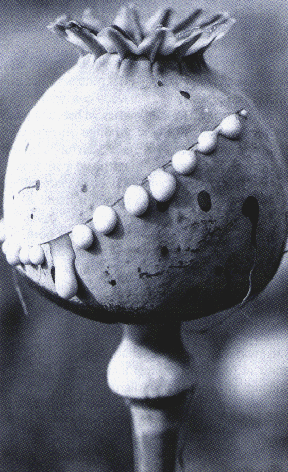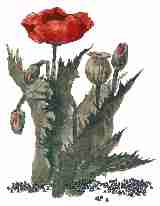Opium Trading in India;
almost a century oldBy Our Correspondent,
Mumbai, October 16The land is dry and unyielding under a blazing sun and for ages now local people have worked these fields with their eyes turned skyward, waiting for the rains. Their crop is a fragile one, sensitive to the whims of the unpredictable weather. It must be harvested carefully and quickly. Welcome to the harvests of India, one of the largest opium harvesting countries in the world. Tucked away in the remote interiors of North India, acres of poppy fields produce tons of precious opium that is perfectly legal and reported to be strictly regulated by their government.
However some of the opium grown here ends up on the black market or is saved for the villagers’ personal use. India is said to be a transit route for illicit heroin, hashish, and morphine base from Afghanistan, Pakistan, Burma, and to a lesser extent, Nepal. Cannabis smuggled from Nepal is mainly consumed within India, but some makes its way to western destinations.
Heroin seizures data during 2000 may point to increased illegal production of heroin within India from opium gum diverted from the licit fields. Some heroin locally produced from diverted opium gum was bound for the international market, including the United Kingdom and Sri Lanka. India is a transit area for heroin from Afghanistan and Pakistan and from Southeast Asia (Burma, Thailand, and Laos). Most heroin transiting India appears bound for Europe.
According to sources the political change in Afghanistan the city of Mumbai may have become a new transit route. Agrees the former police commissioner of Mumbai, M N Singh, “It may be the case due to the change there but it is much less than the 80’s.” According to Singh the funding and the route may have been re-opened by Pakistan to fund the terrorist organizations in and around the country. “The drug money has always been used for such unlawful purposes and the Mumbai police should gear up to control the rise in drug trafficking,” said Singh.
Licenses for small plots for opium cultivation have been granted to 170,000 families in India, in 6,900 villages; so, given the usual family size of four to six, atleast a million people are directly involved. Even though there are reports that the farmers are also involved in trafficking Singh believes otherwise. “Farmers may not be involved as I have during my childhood been to these fields where I have seen the crop being cut and dried to make opium. The farmers are poor people and this is their livelihood so it is unlikely that they may be involved in this racket,” said Singh adding that the fruit of the left over plant is very delicious to eat.
One of the other major places for producing opium is Nimach in Madhya Pradesh. Almost in each place hundreds of rectangular pans, each filled with about 30 kilos of opium, sit in the sun at regular intervals. Those pans hold nearly 35 tons of opium.
There is also a factory at Ghazipur where workers who are smeared with opium take a shower and wash their clothes, watched by men from the Central Industrial Security Force. More opium is recovered from the runoff. Here too a lot of opium is produced and sold off in the black market during transit to the government factories and go-downs.
Bhawani Mandi is a small border town in Jhalawar district of the picturesque State of Rajasthan, best known for its orange, opium and coriander fields. “The place is very famous and cops are scared to venture into this territory as even before an officer leaves his office for undercover investigation the peddlers there are ready to for him,” said a senior police officer from the ANC.
Jhalawar, 87 kms to the south of Kota, is Rajasthan's once and future destination. It is a rock-strewn, scrub-covered terrain, occasionally bright with fields of poppies and citrus-green groves of oranges. It was once a thriving town on a caravan route and now is now at the center of an opium-producing region. This is a small and off-route archeological town with very few visitors.
Ratlam is also one of the main places for peddlers on the western side. Many top drug peddlers like Solanki and Papa Chinaya get their drugs through small carriers from these places. Solanki, who was recently arrested, lived on the border of Madhya Pradesh and Rajasthan. He used to smuggle drugs from there to Mumbai and sell them at higher prices.
India is one of the world’s top producers of licit opium and is the sole producer of licit opium gum. To meet India’s share of anticipated world demand for licit opium in 2000 and rebuild domestic stockpiles toward an International Narcotics Control Board (INCB)-recommended level of about 750 metric tons the Indian government set a licit opium harvest target of 1,200 metric tons. 870 metric tons for export, 130 metric tons for domestic use and 200 metric tons for buffer stocks.
To meet this goal, for the third consecutive year, the Indian government continued to license a historically larger number of farmers and an increased area for poppy cultivation. For the 2000-opium harvest season, the Indian government licensed 159,884 farmers to cultivate opium on 35,271 hectares.
The 2000 harvest yielded 1,302 metric tons at 90 percent solid, the highest ever in Indian opium history. This was some 300 metric tons higher than the 1999 harvest of 971 metric tons from roughly the same amount of cultivated land and exceeded the GOI’s target of 1,200 metric tons. The average opium yields in Madhya Pradesh, Rajasthan, and Uttar Pradesh were 55.79 kilograms, 53.82 kilograms and 44.77 kilograms respectively. The level of diversion from the licit opium crop, while always difficult to estimate, clearly declined from an alarming level in 1999, when up to 300 metric tons of opium gum may have been diverted to the black market. For the crop year 2001, the total licensed area has been reduced from 35,271 hectares to 25,375 hectares. Cultivators who had failed to achieve qualifying yields (at least 45 kilograms per hectare in Madhya Pradesh and Rajasthan) in the previous year were de-licensed. While criminal elements produce heroin from both diverted legal opium and illegally grown opium, no reliable data are available on the extent of production.
NCB sources however state that farmers often hide the exact quantity of their yield and sell off some in the black market also.
The government periodically raises the official price paid to farmers to increase incentives to licit cultivators for declaring and selling to the government all licitly grown opium. This price raise is related to the export price the U.S. and other countries are willing to offer in the international market for Indian opium. The Indian government has been increasing the procurement price of licit opium by 20 to 25 percent annually in the last three years. For the crop year 2000, the price schedule was:
Up to 44 kilograms/hectare (Rs.) 630This graduated scale of payment to licensed farmers is designed to encourage greater productivity and prevent diversion to the black market, where opium can fetch prices as much as 25 times higher than the base government price of Rs. 630 per kilogram. The GOI has decided not to raise the procurement price for the crop year 2001. To retain his license to grow opium, the grower must fill his quota of 4.5 kilograms. For one kilogram the government pays him Rs 250 or a meager a fraction of the drug’s value on the black market. Without the license to cultivate opium the farmers would struggle to make ends meet.More than 44 kilograms/hec and up to 52 kilograms/hec—Rs. 650
More than 52 kilograms/hec and up to 60 kilograms/hec—Rs. 800
More than 60 kilograms/hec and up to 80 kilograms/hec—Rs. 1100
More than 80 kilograms/hec and up to 100 kilograms/hec Rs. 1200
More than 100 kilograms/hec—Rs. 1400
The LAW
Control over cultivation of Opium and all matters relating to narcotic drugs and psychotropic substances are regulated by the "Narcotic Drugs and Psychotropic Substances Act and Rules" (NDPS Act & Rules), which provides –
- punishment of upto 20 years Rigorous Imprisonment and fine of upto Rs.2 lakhs for indulging in trafficking of Narcotic Drugs and Psychotropic Substances
- death sentence in case of repeat of this offence
- forfeiture of property of smugglers and their relatives and ascendants
- regulates legitimate trade and commerce of NDPS for medicinal and scientific purposes The "Prevention of Illicit Trafficking in Narcotics Drugs and Psychotropic Substances" (PITNDPS) provides for detention of persons indulging in trafficking of narcotic drugs for 1 to 2 years by an Executive Order.
History
The British, who once ruled India, had then employed Chinese opium dealers to push the Indian grown opium onto Chinese officials in hope of a widespread addiction. By the mid-1830’s, about one percent of the Chinese population was addicted. In coastal provinces, where smuggling occurred, the number reached as high as 90% addiction. In 1836, enough opium was exported from India and imported into China to cater 12-million addicts. Opium profits soared and the people of India prospered at the downfall of China’s opium abuse.During the early nineteenth century the trade in opium (especially Malwa opium) played a pivotal role in integrating Malwa (western Madhya Pradesh) and the West Coast of India with China and thus with the international capitalist economy. This was also the time when Bombay became the main commercial and financial centre of Western India. Sources state that the export of opium to China was a critical factor in the rise of Bombay to preeminence as well as in the emergence of the Indian capitalist class centered on the port.
HOME
Opium
Images
Opium War
Opium People
Indian Opium
Opium Timeline
Painkillers/brain
Just For Chemists
The Golden Route
Pain and Prohibition
Opium Advertisement
The Afghan Connection
Heroin: A Drug Fit For Heroes?
Confessions of an English Opium Eater
Opium Smoking and Paraphernalia: a bibliography
Vicodin: 'some of them actually think they deserve it'

